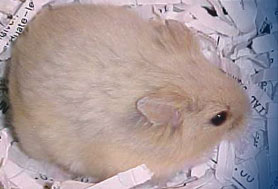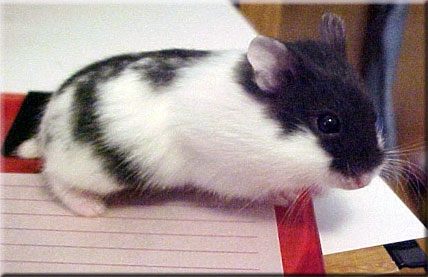Mottled
The gene for mottling (mi) is
dominant lethal. If two mottled hamsters are bred together,
statistically 25% of the offspring will be eyeless, toothless
whites that will die within the first few weeks of birth. For
this reason, only one parent should be mottled. Statistically,
50% of a litter with one mottled parent, will be mottled. Pictured
from left to right: black mottled, blue mottled, blue mottled
and red eyed argente mottled.
There are 2 mottling genes, the ruby mottled
gene (mi) and the non-ruby-eyed mottled gene (mo).
The ruby gene is the only gene in the United States currently
(all ruby eyed mottled hamsters will have a red glow to their
eyes when held up to a strong light). The non-ruby-eyed version
is known mainly in the UK.. The non-ruby-eyed mottled gene
is NOT Lethal.
If you live in the United States and have a mottled hamster
you want to breed, assume it is the lethal ruby-eyed variety
and cross to a solid color. By doing this, you avoid the chance
of getting eyeless, toothless whites as you might when crossing
two ruby mottled hamsters. If two ruby eyed mottled hamsters
are crossed, approximately 25% will be deformed eyeless toothless
whites. These babies are the ones that inherited two doses
of the ruby-eyed mottling gene. Any baby that gets one dose
will be mottled without being deformed.
Note: There seems to be a "facial white" gene
that is tied to the mottling gene. Few hamsters show it but
those that do are mottled. Here is a picture of one of the
few facial white babies I have produced. Click the picture
to see a larger image.:

|



















